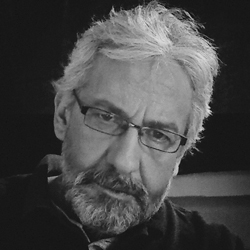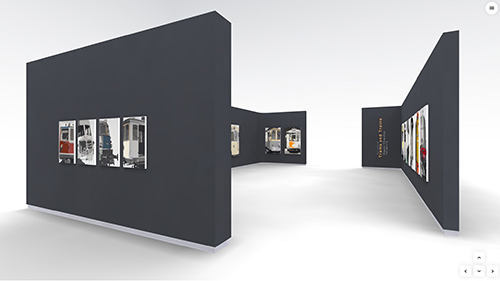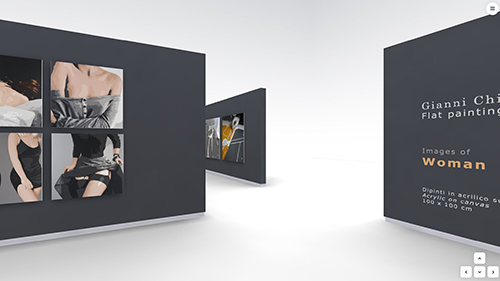Gianni Chiacchio
Portraits of trams and trains - images of woman
(Flat painting)
2020
Portraits of
Trams and Trains
DIPINTI IN ACRILICO SU TELA
ACRYLIC ON CANVAS
PORTFOLIO
Acrylic on canvas 16 0 x 100 x 4 cm
Acrylic on canvas 100 x 160 x 4 cm
Acrylic on canvas 80 x 50 x 4 cm
Images of
Woman
DIPINTI ACRILICO SU TELA
ACRYLIC ON CANVAS
PORTFOLIO 2
Acrylic on canvas 100 x 100 x 4 cm
CHI SONO
About

Sono un artista e uno scenografo di professione. Sono nato e cresciuto a Milano, Italia, e vivo a Bruxelles, Belgio dal 2005.
La mia esperienza professionale come scenografo inizia negli anni ottanta. Per oltre venticinque anni ho lavorato per la televisione, il cinema, la pubblicità, eventi per la moda, shows e allestimenti promozionali.
Dal 2008 ho scelto la pittura come laboratorio per la mia ricerca tecnica ed estetica, dopo un percorso creativo e artistico attraverso più forme e discipline espressive.
Oggi dipingo a pennello, con la tecnica delle campiture piatte. La pittura a tinta rigorosamente piatta è parte costitutiva del mio linguaggio: una pittura poco interessata alla prospettiva, alla profondità, alle ombre. L’insieme compositivo richiama la serigrafia nelle sue qualità decorative basate sul segno applicato direttamente sulla matrice. Ma il mio procedimento è diverso: parto dalla matrice (le campiture), ne elaboro le qualità grafiche attraverso il segno, conservo le tracce della lavorazione sul supporto.
Sulla tela, chiaroscuro e sfumature sono eliminati e le ombre semplificate, accorpate, amalgamate e condensate in campiture che si incastrano tra loro come tessere di un puzzle. Le gradazioni tonali sono distribuite in un susseguirsi di campi monocromi, dalla cui posizione dipende un nuovo tipo di profondità. La scala cromatica è limitata sui bianchi e sui grigi, ai quali sono accostati richiami al colore reale del soggetto. Una composizione pulita, in bilico sul confine dell’astrazione formale.
I am an artist and a professional set designer. I was born and raised in Milan, Italy, and have been living in Brussels, Belgium since 2005.
My professional experience as a set designer began in the eighties. For more than twentyfive years I worked for television, cinema, advertising, fashion events and promotional shows.
Since 2008 I have chosen painting as the laboratory for my technical and aesthetic research, after a creative and artistic journey through multiple forms and expressive disciplines.
Today I paint with a brush applying the technique of flat backgrounds. Strictly flat colour painting is a constitutive part of my language: a painting that is not interested in perspective, depth or shadows. The composition is a reminiscent of silkscreen printing in its decorative qualities based on the sign applied directly to the matrix. However, my procedure is different: I start from the matrix (the backgrounds), I elaborate its graphic qualities through the sign, I keep the traces of the working on the support.
On the canvas, chiaroscuro and nuances are eliminated and shadows are simplified, merged, amalgamated and condensed into backgrounds that fit together like pieces of a puzzle. The tonal gradations are distributed in a succession of monochrome fields, from whose position depends a new type of depth. The chromatic scale is limited on the whites and greys, which are combined with references to the real colour of the subject. A clean composition, poised on the boundary of formal abstraction.
GALLERIA
Expo
LA TECNICA
The technique
IN PAROLE
In words
Nel corso della mia professione ho avuto l’opportunità e l’interesse ad approfondire ed integrare altre discipline come la grafica e la fotografia. L’integrazione di più forme e discipline espressive, oltre a soddisfare il piacere della ricerca (…), mi ha permesso di approfondire e ravvivare il mio percorso creativo e artistico.
Successivamente mi sono avvicinato alla pittura perché la consideravo un altro mezzo affine e in continuità anche con la mia professione. Un nuovo mezzo, una nuova ricerca, solo in parte collegata alla mia esperienza professionale, ma che si è rivelata in breve tempo come una forma di espressione privilegiata. Alcune discipline artistiche hanno chiare possibilità di interagire tra loro. La pittura ha il sopravvento. Quella che consideravo una nuova esperienza da includere ed integrare nelle precedenti, si è rilevata una ripartenza dal grado zero.
Ho iniziato un nuovo percorso di ricerca, una nuova forma espressiva, dove inevitabilmente il punto di partenza erano le mie esperienze di scenografo e grafico, ma adattate al nuovo mezzo. Ho così lavorato per quasi dieci anni per trovare una mia personale forma espressiva e una tecnica che mi fosse congeniale.
Ho scelto la tecnica delle campiture piatte, a favore di una superficie asettica, levigata: un effetto che, sebbene raggiungibile con varie tecniche di applicazione indiretta (ad esempio la pittura a spray, la serigrafia o il collage), ho voluto ottenere con l’utilizzo dei pennelli.
Questa tecnica coincide con il mio obbiettivo espressivo, una pittura poco incline alla prospettiva, in cui le ombre sono riassunte in campiture e la profondità dell’immagine emerge dall’accostamento di campi monocromi. Ho eliminato le linee di contorno, per definire le campiture solo attraverso la mascheratura.
Il metodo di lavorazione cloisonné degli smalti applicati sui metalli, da cui parte la mia ricerca, ha una linea di contorno (un filo anch’esso di metallo) che racchiude le aree da riempire uniformemente col colore e mantiene il disegno della linea a separare le sue campiture (generando un effetto simile a quello delle vetrate delle cattedrali).
Questa una scelta apparentemente solo stilistica, ma che in realtà racchiude una delle idee formative che sono emerse nel corso delle sperimentazioni e che insieme alla tinta rigorosamente piatta caratterizza il mio lavoro: il rigore e l’attenzione al dettaglio, una pittura che diventa minimalista, rigorosa, precisa, lenta. Una pulizia vibrante e una sottrazione di tutto ciò che potrebbe non essere necessario per individuare l’immagine. Come nei ricordi, le immagini della nostra memoria si assottigliano, perdono definizione, colore, forma.
Utilizzo il colore acrilico fine e lo smalto acrilico satinato perché tendono, per le loro caratteristiche, a rendere fluida l’immagine, un effetto di luce annebbiata e lontana.
Così anche i miei treni e i miei tram, che sono da subito i protagonisti della mia pittura, ho voluto e voglio raccontarli nel “ricordo” e nello stesso tempo renderli protagonisti di un racconto nel tempo. Sono frammenti di narrazioni che furono complete ma di cui si è perso l’incipit e l’epilogo, singoli fotogrammi di una pellicola, racconti che si fermano in una sospensione temporale che è riflessione e nostalgia insieme. Ne nasce un mondo silenzioso, che parla senza voce.
I miei treni e i miei tram diventano ritratti dei protagonisti, interpreti di una storia raffigurante un momento nel tempo. Lo spettatore aggiunge la narrazione.
Infine, il bisogno di un ritorno alla manualità è stato un altro stimolo di partenza di questa mia ricerca. La materia, il toccare. Far ritornare le mani protagoniste del mio lavoro e insieme la necessità di riflettere su ogni mia azione, sull’irreversibilità che un semplice gesto spesso porta in sé.
In the course of my career I have had the opportunity and the interest to deepen and integrate other disciplines such as graphics and photography. The integration of several forms and expressive disciplines, in addition to satisfying the pleasure of research (...), allowed me to deepen and revive my creative and artistic path.
Subsequently I approached painting because I considered it another medium similar and in continuity with my profession. A new medium, a new research, only partly related to my experience, but that has turned out in a short time as a privileged form of expression. Some artistic disciplines have clear possibilities to interact with each other. Painting has the upper hand. What I considered a new experience to be included and integrated in the previous ones was a restart from degree zero.
I started a new path of research, a new form of expression, where inevitably the starting point was my experience as set designer and graphic designer that I adapted to the new medium. I worked for almost ten years to find my own personal form of expression and a technique that was congenial to me.
I chose the technique of flat painting to obtain an aseptic, polished surface: an effect that, although achievable with various techniques of indirect application (such as spray painting, screen printing or collage), I wanted to obtain with the use of brushes.
This technique coincides with my expressive objective, a painting not very inclined to perspective, in which the shadows are summarized in backgrounds and the depth of the image emerges from the combination of monochrome fields. I have eliminated the contour lines, to define the backgrounds only through masking.
The cloisonné working method of enamels applied to metals, from which my research began, has a contour line (a metal wire too) that encloses the areas to be filled uniformly with colour and maintains the design of the line to separate its backgrounds. This generates an effect similar to that of the windows of cathedrals.
This is an apparently stylistic choice that contains one of the formative ideas that emerged during the course of the experiments and that, together with the flat colour, characterizes my work: rigour and attention to detail, a painting that becomes minimalist, rigorous, precise, slow. A vibrant cleanliness and a subtraction of everything that may not be necessary to identify the image.
As in the memories, the images of our memory become thinner, they lose definition, colour and shape.
I use fine acrylic colours and satin acrylic enamel because of their characteristics that tend to make the image fluid, an effect of foggy and distant light.
Trains and trams are, from the start, the protagonists of my painting. I wanted and want to narrate them in the "memory" and at the same time make them protagonists of a story in time. They are fragments of narratives that were complete but whose beginning and end have been lost, single frames of a film, stories that stop in a temporal suspension that is both reflection and nostalgia. The result is a silent world that speaks without a voice.
My trains and trams become portraits of the protagonists, interpreters of a story depicting a moment in time. The viewer adds the narration.
Finally, the need for a return to manual skills was another stimulus for my research. Matter, touching. To bring back the hands at the centre of my work and at the same time the need to reflect on all my actions, on the irreversibility that the gesture often carries within itself.
IN EVIDENZA
Highligth
24 December 2022 - December 2023 - Solo Exhibition Gallery Jean Nelis - Rue Coppens 2 - 1000 Bruxelles - BE
September 2022 - Solo Exhibition Gallery Jean Nelis - Rue Coppens 2 - 1000 Bruxelles - BE
April / May 2022 - Solo Exhibition Gallery Jean Nelis - Rue Coppens 2 - 1000 Bruxelles - BE
September 2020 - ART 3F Luxembourg 2019 - LuxExpo - The box - Parc Expo
November 2019 - ART 3f Bruxelles 2019 Brussels Expo - Palais 1 Place de Belgique 1 - 1020 Bruxelles -BE
April 2019 - ART 3f Luxembourg 2019 - 10, Circuit de la Foire Internationale L-1347 - Luxembourg-Kirchberg
November 2018 - ART 3f Bruxelles 2018 Brussels Expo - Palais 1 Place de Belgique 1 - 1020 Bruxelles -BE
April 2017 - September 2018 - Solo Exhibition Tijdok 28 Private Gallery Tijdokstraat 28 - 8380 Zeebrugge - BE
August 2018 - ART NOCTURNE KNOCKE 2018 - CC Scharpoord, Meerlaan 32 at Knokke-Heist, Belgium
April 2018 - KÖLNER LISTE Contemporary Fine Art 2018 - XPOST Köln - Gladbacher Wall 5 - 50670 - Cologne - DE
October 2017 - ACCESSIBLE ART FAIR 2017 - BOZAR - Rue Ravenstein 23 - 1000 Bruxelles - BE
April 2017 - KÖLNER LISTE Contemporary Fine Art 2017 - XPOST Köln - Gladbacher Wall 5 - 50670 - Cologne - DE
September 2016 - ACCESSIBLE ART FAIR 2016 - Jewish Museum of Belgium - Rue des Minimes 21 - 1000 - Bruxelles - BE
September 2016 - ROTTERDAM INTERNATIONAL ART FAIR 2016 - De Laurenskerk Grotekerkplein 273011 GC - Rotterdam - Netherlands
October 2015 - ACCESSIBLE ART FAIR 2015 -The Cercle De Lorraine - Bruxelles - BE
September 2015 - "OPEN" ART EXHIBITION - Light Space & Time Gallery Special Recognition
June 2015 - DONKEYARTPRIZE - Painting Prize Finalist 2015
CONTATTI
Contact
Tutte le immagini pubblicate in questo sito sono protette dalla legge sul diritto d'autore; l'uso non autorizzato di qualsiasi foto costituisce un'aperta violazione del copyright. The images may not be reproduced, copied, transmitted or manipulated without the written permission of the author. Use of any images is a violation of the Copyright laws.

